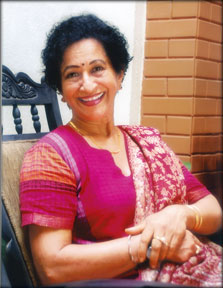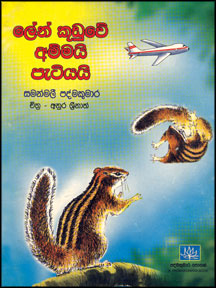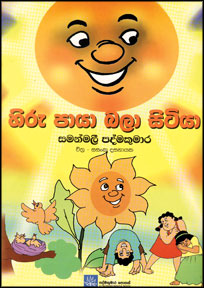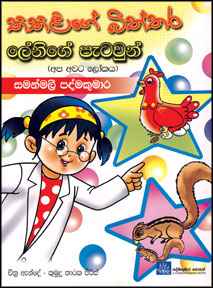|
Literatus in children's literature :
Fascinating expedition into the rainbow world
By Ranga CHANDRARATHNE
Good children's literature appeals not only to the child in the
adult, but also to the adult in the child
- Anonymous
Children's literature forms an important segment of mainstream
literature. Since children's literature deals with young, tender minds,
writers of children's literature should not only be knowledgeable on
literature but also on child psychology.
 |
|
Samanmalee Padmakumara, author and
lyricist |
Samanmalee Padmakumara, a senior writer specialises in children's
literature. Over the years, she bequeathed on the nation a rich and
fascinating body of children's literature which is uniquely Sri Lankan.
One of the prominent characteristics of her writings and
illustrations she used for her books, is her ability to integrate
cultural motifs into them. Her books stand out for their elegant
illustrations and the moral messages encoded in them.
In a wide ranging interview with the Sunday Observer , Samanmalee
Padmakumara spells out her lifelong mission and her abounding love for
children and children's literature. Her body of writings includes a
large number of children's books in Sinhala and English and a CD titled
Kumbalo, Leno, Alipatiyo.
As a lyricist, she also outrivals her peers in children's songs. Her
latest CD bears testimony to her innate ability to compose lyrics
appealing to the young generation. Her work has already become part and
parcel of artistic legacy of the Sri Lankan literature. In composing
lyrics, she has used short lines that will reflect in the minds of young
listeners. The structure of the lyrics is rhythmical and mellow.
Another prominent feature of the lyrics is the use of down-to-earth,
refined language which helps lay a firm foundation in the young
listeners, improving their tastes.
Her effort should be commended particularly at a time when the
Sinhalese language is degenerating at the hands of some pseudo-literati.
Excerpts of the interview:
Q: Sri Lanka has a rich tradition of bedtime story-telling. This has
resulted in a rich repository of children's stories and folk tales. In
your series of books for children, how did you adapt your stories to
interest modern children who spend most of their time watching
television or playing video games?
A: There was a time when the tradition of bed-time story-telling was
the main form of story-telling practised not only in Sri Lanka, but also
in other parts of the world. This tradition may have remained for
centuries, but many changes have now taken place due to the advancement
in technology and inventions such as the camera, television, computer
and Internet.
To some extent, these developments have affected the lives of people
around the world. The traditional pattern of life in which the father
goes to work leaving the mother to look after the child at home is
absent today. Unlike in the past, now the mother also goes to work, away
from the house, while the children attend school.
School is the only place where children interact with their peers.
Since the classrooms are overcrowded, children cannot interact with each
other in the manner they did in the past. Teachers cannot pay attention
to each child in the classroom. So it has now become group work.
Traditionally, the knowledge of religion was given to children at
home, temple, church or at another place of religion through stories,
poetry and parables. But that tradition is not alive in the same manner
any more as society switches on to a speedy lifestyle. Therefore,
attention should be paid to devising new methods of engaging children in
story-telling, reading and writing.
We could not achieve this objective without institutional backing.
For instance, we need the cooperation of the printing sector and
electronic media such as television to promote story-telling. Children
prefer watching television to reading due to various reasons.
Children's programs on TV
Are they looking for stories and songs on television? The answer is
often in the negative. In most households, children watch television
along with adults and most of the programs they watch are not suitable
for them. Except for a few children who actually watch children's
programs, others pay little or no attention to them.
|
 |
|
 |
 |
|
 |
 |
|
 |
 |
|
 |
 |
|
Some of
Samanmalee Padmakumara’s many creations |
How could we make not only the children, but also adults and teachers
aware of the wonderful systematic pattern of listening to children's
stories? For that, adults have to sacrifice some of their time.
For example, in my childhood, I used to tell stories instead of
listening to stories. I also sang and wrote poetry. But over the years,
lifestyles have changed. Are we going to adapt ourselves to modern
lifestyles and at the same time inculcate in our children the habits of
reading, listening to stories, story-telling and dancing? Earlier,
children engaged in these activities for pleasure.
But the situation has changed. Now, everything is aimed at a
profession or for future employment. For example, those days when we
were attending classes for dancing, we had to watch the students of the
previous class performing and the class after ours. But now, children
don't have time for that. Are we going to change this fast- paced
lifestyle for the betterment of children? Eventually, we will have to
change it....
I entered the world of printing in 2000. Before that I had been a
public speaker, irrespective of whether I was the chief guest at
functions or attending them as an invitee. I realised that I am capable
of attracting children as well as adults. That shows that children's
books are meant not only for children, but that adults can also
appreciate them. Adults can read books to children. Technological
inventions such as television and the Internet would help little in
improving children's creativity compared to reading books.
But, at the same time, we cannot ignore modern inventions and
technology. We cannot always write stories featuring bullock carts
because bullock carts are history. We have to write stories about cars,
vehicles, bicycles, planes and submarines and to teach children that
there is beauty in these inventions.
When children appreciate them, they will use them profitably. My
first four books dealt with these changes.
The book titled Len Kuduwe Ammai Patiyai featured a baby squirrel,
mother squirrel and an aeroplane. Many asked me why I included a plane
in the book. I told them that a plane is also a kind of bird.
Magegedara Vada Pirila (I am busy at home) explains that it is not
only adults who are busy, but also children. For them, playing and
making toys are tasks.
The book ends with the child saying that her father has gifted her
with a laptop computer, only to watch cartoons. We have to add these
inventions carefully to children's literature.
There should be a time table for children. A little time should be
allocated for reading. Reading makes a strong personality.
We should not go on a rat race; a child goes to school and then to
tuition classes, returns home and then goes to bed.
This life pattern should be changed or else it will produce a
mentally and physically-imbalanced generation which will be a major
issue in the future.
Traditional stories
Q: Apart from using traditional children's stories, you have created
a host of stories of your own. What are the morals that you intend to
inculcate in children through them?
A: I don't have any traditional stories in my books. All the stories
were born in my imagination.
I have a mission and that is to give something nice to the world. It
is the plain truth that distinguished professionals have done something
different to the usual pattern.
I wrote the same thing, but in a different way. I had a colourful
childhood. We used to play a lot and I behaved mostly like a tomboy,
even climbing trees. For me, as a child, Colombo was not a city.
Then, Colombo was full of paddy fields with cows and bulls walking on
the road. There were bullock carts. I plucked Uguressa and Bakini off
trees.
Q: In your stories, you have introduced the National Flag and diverse
ethnic groups in Sri Lanka. It seems that you intend to promote ethnic
harmony, national integration and love for the motherland. What is the
response to your series from young readers?
A: As a child, I used to carry a tiny paper fixed on to a wooden stem
and run around the house shouting Jaya Weva (victory). We knew nothing
about politics. When I was a director of pre-schools, I asked the
teachers to make flags of different colours and shapes, e.g. square,
round and triangular flags. Twenty years ago, I wrote the book on the
National Flag. I wrote a book on the national flag of India as well.
That's why Sonia Gandhi appreciated my work. But I never published it.
First I wrote the book in English.
The reason for publishing the book in English is that there are
Tamil, Muslim and even Sinhalese children who could not read Sinhala.
Later, I published the book in Sinhala and English. I really wanted
to publish the book in Tamil.
The first response came from an adult who said that until he read the
book, he did not know anything about the national flag and its main
features such as compassion, love, kindness or tolerance. I said that
all Sri Lankans have those four qualities. Publishing children's books
is expensive. I published my own books.
Indigenous tradition
Q: Singapore, for instance, has established an indigenous tradition
of children's literature which is highly appreciated and studied beyond
its shores. What do you think are the measures that the Government in
general and the Ministry of Cultural Affairs in particular can take
towards establishing an indigenous tradition of children's literature in
Sri Lanka?
A: Twenty years ago, there was little interest towards establishing
pre-schools. There wasn't a ministry to take care of children. At the
time, children were brought up at home as the mother was at home.
Subsequently, the situation changed. Informed citizens wrote to
newspapers of the situation.
In response, the government sector came out with good day care
centres for children with facilities to develop the mental and physical
well-being of the children.
The culture of fast food should be changed to ensure that children
should get used to good food habits. Now there are nine-year-old
children with high blood sugar levels. Therefore, this pattern of life
has to change.
Q: Children's literature can also be used as a tool of education and
to inculcate positive values in children. Have we exploited this
potential in children's literature?
A: Children's literature does not mean only reading. Dancing,
singing, story telling, acting and script-writing can also be considered
as children's literature. What is needed is to integrate them into life.
Although curricular activities are important, extra-curricular
activities such as dancing, singing and painting are also important to
build a balanced personality. Dancing and singing should not be confined
to specific areas, but they should be part and parcel of life.
Q: Sri Lanka can mark its name on the world's literary map if Sri
Lankan children's literature is either translated into Standard English
or written originally in Standard English. Have we looked into this
aspect?
A: A few Sri Lankans have already earned international reputation in
this arena. You need to have a good heart before becoming wise.
We have to present children with books and adults should read them to
children because children love to see parents and adults read stories to
them. It is a healthy trend that newspapers have children's supplements
and tabloids.
|

